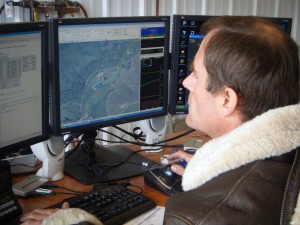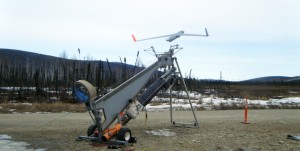Unmanned aircraft to assist statewide emergency exercise
April 23, 2010


Amy Hartley
907-474-5823
4/23/10
Three 40-pound unmanned aircraft from Poker Flat Research Range will support Alaska Shield, a statewide exercise April 26 through May 2, 2010 that will test Alaska’s ability to respond to a major disaster. Although the aircrafts’ specific mission will remain unknown until the exercise begins, Poker Flat staff members are prepared to launch and fly the aircraft in the Anchorage area.
The three Insitu ScanEagles are equipped to capture high-resolution optical video or infrared data from as high as 19,000 feet in real time. For the exercise, they will fly in military restricted airspace and only as high as 10,000 feet. This will allow emergency responders a birds-eye view of communities affected by the mock disaster during the exercise. The unmanned aircraft are a welcome aid to responders, who will need to analyze the extent of damage in order to react swiftly. The exercise scenario remains a mystery. However, participants do know that it will hinge on a large earthquake rocking southcentral Alaska. The simulated disaster will include mock effects on people, infrastructure and supply chains, and will include communities as far away as Unalaska.
Poker Flat Research Range manager Greg Walker and Geophysical Institute electronics shop manager Jeff Rothman will travel to Anchorage to pilot the aircraft from the ground-control station based on Fort Richardson. Kathe Rich, Poker Flat operations controller, will join the pair in Anchorage and will handle exercise logistics. Most critically, Rich will work in the Joint Operations Center and State Emergency Coordination Center to offer coordinators information on the capabilities of the unmanned aircraft. She will also convey tasks to the pilots. Range affiliate Ro Bailey will work in the “white cell,” where exercise scenarios and resulting effects are built and then transmitted to exercise participants.
“Use of our aircraft could shorten days of confusion should a major disaster strike Alaska,” Bailey said.
Poker Flat Research Range is one of a multitude of state, city and military partners that will collaborate during the exercise. The State of Alaska Division of Homeland Security and Emergency Management is the lead agency coordinating the exercise. Planning for the Alaska Shield exercise began in 2007.
Poker Flat Research Range is a remote research site located north of Fairbanks on the Steese Highway. The University of Alaska’s unmanned aircraft are based at the range, which is also home to scientific sounding rocket missions launched during the winter months. The Geophysical Institute at the University of Alaska Fairbanks operates the range, under contract to NASA.
ADDITIONAL CONTACTS: Ro Bailey, Poker Flat Research Range affiliate, 907-455-2104, or rbailey11@alaska.edu. Greg Walker, Poker Flat Research Range manager and pilot, 907-455-2102, greg.walker@gi.alaska.edu.
NOTE TO EDITORS: Photos of the unmanned aircraft are available online at www.uaf.edu/news.
AH/4-23-10/208-10


